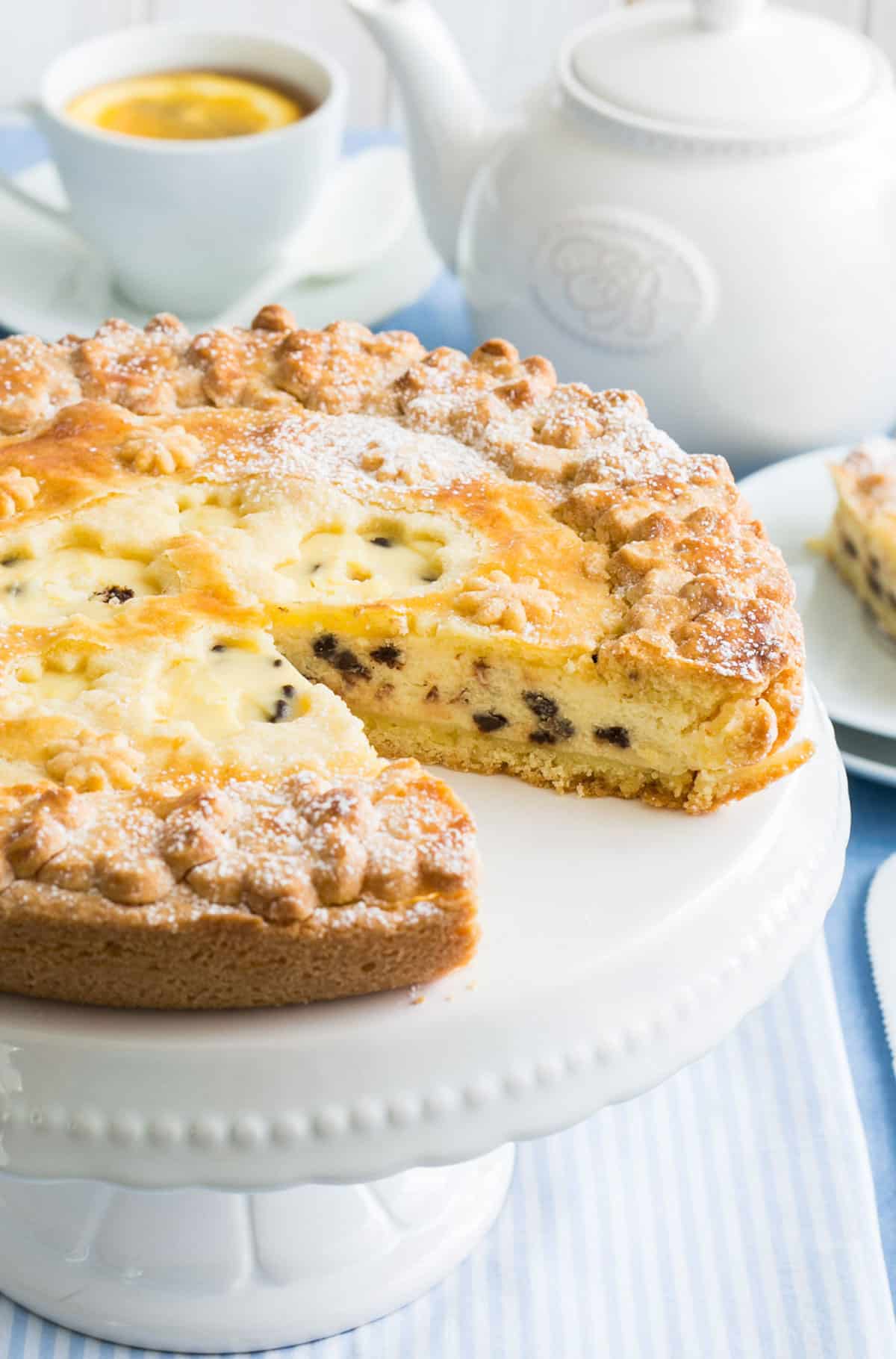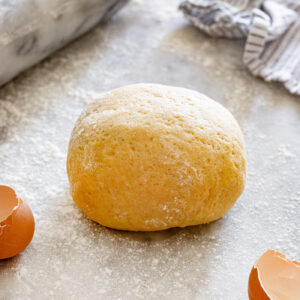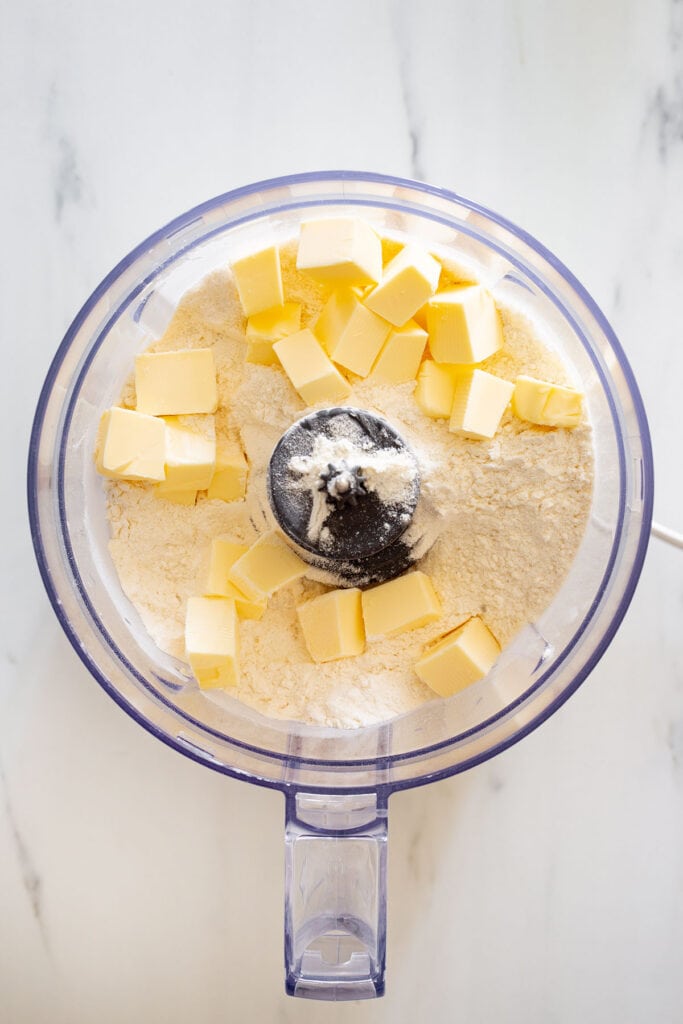Learn how to make pasta frolla recipe from scratch with this super easy step-by-step guide. This shortcrust dough has a delicate flavor and is perfect to make many Italian desserts!
Pasta Frolla is an Italian basic pastry dough made of flour, butter, eggs, and sugar. The dough is mainly used in the preparation of crostate (pies) and cookies, both sweet and savory.
As in many traditional recipes, there are various ways of making pasta frolla depending on the local uses or the final recipe.
The variations may include other ingredients such as chocolate or nuts to give an extra crunch, or some may include a bit of baking powder to make the dough softer.
I decided to go with the classic pasta frolla recipe as this will give you a base to make countless Italian desserts, like this crostata di ricotta.
This is a quick and easy recipe using a food processor to speed up things, yet it delivers a delicious, aromatic, and crumbly sweet pastry dough that will be perfect to make pie, tarts, and cookies.

Ingredients
- Flour: You will need all-purpose flour, known in Italy as 00 flour. Make sure to measure it by spooning it into a cup.
- Unsalted butter: Use your favorite brand of butter but make sure it’s cold and not at room temperature or softened.
- Eggs: For this recipe, I used 1 medium egg, which weighed about 1.8 ounces (50-52g). If you want to use a large egg make sure to add half of the water asked in the recipe.
- Sugar: Use granulated sugar, or substitute it with confectioners sugar for a softer dough.
- Salt: Use fine salt.
- Aroma: In Italy, the most common aromas to add are lemon zest or orange zest, vanilla extract, rum, or orange blossom water.
Note: Those ingredients will make about 1.1lb (500g) of frolla dough, which is enough to use in a 9-inch (22cm) tart pan.

How To Make Pasta Frolla
Place flour, sugar, salt, and cold butter in a food processor. Pulse two or three times until you get a sandy mixture.
Add the egg, vanilla extract, and 2 tablespoons of cold water.
Pulse a couple of times to combine all the dry ingredients then process for about 20 seconds at low speed until you’ll have a soft dough.

Pro Tip: Make sure the water is cold from the fridge so it won’t melt the butter and compromise the frolla dough texture.
Sprinkle a work surface with flour and transfer the dough there. Quickly knead for a few seconds to combine the ingredients into a ball.

Wrap the frolla dough ball with cling film and place it to chill in the fridge for at least 30 minutes before using it in your recipe.
When ready to use, sprinkle with flour a working surface and roll the dough as instructed in your recipe.

Recipe Tips & Notes
- For a perfect frolla dough, I strongly recommend using a kitchen scale. You can find the metric measurements in the recipe card below.
- Depending on the type of texture you want to achieve, the amount of butter can vary from 30% to 70% of the weight of the flour. Most recipes use 50%, for example, 10oz flour = 5oz butter.
- You can also use only the egg yolks to make this recipe, it will result in a softer dough once baked.
- Adjust sugar to your liking, in most Italian recipes for this pastry dough the amount of sugar ranges from 30% to 60% of the weight of flour.
- Leaving out sugar and adding 1-2 teaspoons of salt makes a perfect dough for savory tarts, pies, and cookies.
- Some recipes include baking powder to make this shortcrust dough, it will add some fluffiness which is perfect to use in tarts with lots of filling.
- If possible, use a marble pastry board and marble rolling pin, to prevent the dough from heating and becoming too soft.

2 different methods for making the dough
This dough has two methods to prepare and each one is equally good, changing only a little the texture of the final product:
- Traditional method: Using your fingers, a fork, or a food processor, first mix the butter (very cold) and the flour to make a sandy mixture that is precisely what will make the dough once baked a lot more crumbly. The rest of the ingredients are kneaded very quickly afterward to prevent heating the dough.
- Whipping method: Using an electric mixer, first mix softened butter and sugar into a cream using the wire whip and then mix the rest of the ingredients using the flat beater. This method gives a smoother, more compact crust once baked.
How To Use
Italian pasta frolla is used to make many traditional recipes, the most popular is crostata, a sweet tart usually filled with crema pasticcera (pastry cream).
The basic recipe is also used to make cookies and pies.

Storage
Italian shortcrust pastry dough can be stored in the fridge nicely wrapped in cling film for up to 3 days.
You can also store it in the freezer for up to 3 months. I recommend wrapping it with 2-3 layers of film and then placing it in a resealable bag to prevent freezer burns.
When ready to use, transfer the frozen dough to the fridge so it will thaw slowly, then roll it and use it in your recipe.
FAQ
What is pasta frolla made of?
Italian shortcrust dough, also known as pasta frolla, is made of flour, butter, sugar, and eggs.
Recipe origin
Pasta frolla is from Italy where it’s used to make a popular sweet tart called crostata.
How long should shortcrust pastry dough rest?
The recommended time to rest is 45 minutes in the refrigerator, but 30 minutes is also a good time.
No matter which preparation method you prefer, one of the most important things when making this pastry dough is resting time. Without resting, the dough will not have the right consistency to work it later, resulting in a loose dough that breaks or falls apart easily.
More Italian Pastry Recipes
Did you love this Italian recipe? please don’t forget to rate it and leave a comment below. You can also share it on your social media and follow this blog on Pinterest, Instagram, Facebook, and YouTube.
Video

Pasta Frolla Recipe From Scratch
Equipment
- food processor optional
Ingredients
- 2 cups all-purpose flour (250g)
- 8 ½ Tbsp unsalted butter (125g, about 1 stick + 1 Tbsp)
- ½ cup sugar (100g)
- 1 medium egg
- ½ tsp vanilla extract (or lemon zest)
- 2 Tbsp cold water
- pinch of salt
Instructions
- Place flour, sugar, and salt in a food processor. Pulse two or three times to make a sandy and crumbly mixture.
- Add egg, vanilla extract, and water. Work at low speed for about 20 seconds or until all ingredients are combined into a dough.
- Transfer the dough to a lightly floured working surface.
- Quickly knead the dough to finish combining the ingredients and form a ball.
- Wrap the frolla dough with cling film and place it in the fridge for at least 20 minutes.
- Remove the dough from the fridge and transfer it to a floured surface. Roll it and use it as instructed in your recipe.
Notes
- Butter should be cold from the fridge. You can also place it for 5 minutes in the freezer if it is too soft.
- Make sure the water is cold from the fridge so it won’t melt the butter and compromise the frolla dough texture.
- This pasta frolla recipe lasts up to 3 days in the fridge or up to 3 months in the freezer. Make sure to wrap it with cling film and place it in a zipped bag.








Muy buena receta y muy bien explicada, ¡muchas gracias!
Que bueno que te gustó! :)